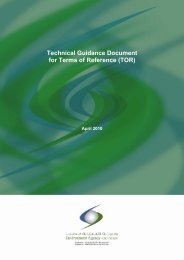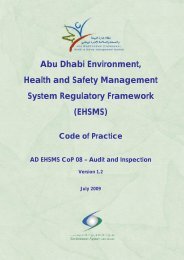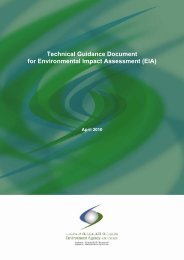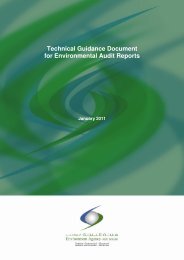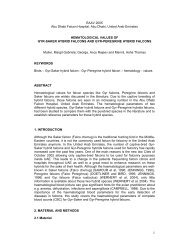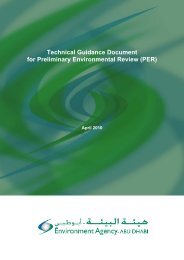Standard Operating Procedure (SOP) for Compliance Monitoring ...
Standard Operating Procedure (SOP) for Compliance Monitoring ...
Standard Operating Procedure (SOP) for Compliance Monitoring ...
Create successful ePaper yourself
Turn your PDF publications into a flip-book with our unique Google optimized e-Paper software.
<strong>SOP</strong> <strong>for</strong> <strong>Compliance</strong> <strong>Monitoring</strong> Using CEMSs<br />
Table 2. International Best Practice Usage of CEMS <strong>for</strong> Various Industries<br />
Industry CO NO x SO 2 THC Opacity PM BLD Hg HCI HF CH 4 Flow<br />
CO 2<br />
or<br />
O 2<br />
Electrical <br />
generation<br />
(natural gas)<br />
Cement kiln <br />
Primary<br />
<br />
aluminum<br />
Electric arc <br />
furnace<br />
Medical waste <br />
incinerator<br />
Municipal waste<br />
incinerator<br />
Sewage sludge<br />
incinerator<br />
Landfill <br />
4. <strong>Monitoring</strong> Locations<br />
CEMS are most commonly located in an exhaust stack or vent. However, CEMS may also be used <strong>for</strong><br />
fugitive emissions monitoring (e.g., emissions from building openings that do not have stacks or<br />
exhaust fans).<br />
5. <strong>Monitoring</strong> Equipment<br />
There are many systems <strong>for</strong> continuous monitoring commercially available. Many factors should be<br />
considered to determine the best equipment <strong>for</strong> a specific source. These factors include, but are not<br />
limited to, the type of system required, design characteristics, environmental requirements,<br />
maintenance and operational considerations, and Environment Agency–Abu Dhabi (EAD)<br />
requirements.<br />
CEMS may be extractive or in situ. With extractive gas monitoring systems, gas is extracted from a<br />
duct or stack and transported to analysers <strong>for</strong> the measurement of pollutant concentrations. Extractive<br />
analysers are designed to monitor source-level gas concentrations, or they can be combined with<br />
dilution systems to measure lower pollutant concentrations. The choice of gas analysers <strong>for</strong> an<br />
extractive CEMS is important because some analytical techniques per<strong>for</strong>m better than others in a<br />
specific source application or system design. One of three analytical methods is generally used to<br />
determine these concentrations: absorption spectroscopic, luminescence, and electroanalytical.<br />
In situ gas monitoring systems consist primarily of an analyser that uses some type of sensor to<br />
measure the gas directly in the stack. There are two types of in situ gas monitoring systems currently<br />
in use. The first type is an across-stack (or path in situ) system that analyses the effluent that passes by<br />
a specific “line of sight” of the monitor, typically ranging from a few feet, to the full distance across<br />
the interior diameter of the stack or duct. The second type is a point in situ instrument, which analyses<br />
the effluent at one specific point or along a short path in the stack or duct.<br />
Technical details on the application of CEMS at thermal power plants and associated emissions<br />
monitoring technologies are provided in Annex 1.<br />
6. Quality Assurance Plan Requirements<br />
A QA program is a type of management system that ensures quality control (QC) activities are<br />
per<strong>for</strong>med. Examples of QC activities include preventive maintenance, daily calibrations, and<br />
quarterly audits. QC activities certify that generated data are complete, representative, accurate, and<br />
3





